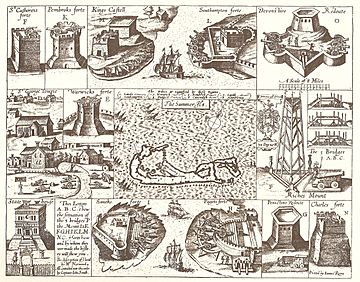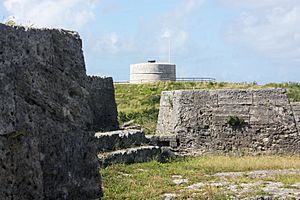Historic Town of St George and Related Fortifications, Bermuda facts for kids
| UNESCO World Heritage Site | |
|---|---|

Captain John Smith's 1624 map of Bermuda, showing contemporary fortifications.
|
|
| Location | Bermuda, British Overseas Territories, United Kingdom |
| Criteria | Cultural: (iv) |
| Inscription | 2000 (24th Session) |
| Area | 257.5 ha (636 acres) |
| Buffer zone | 746 ha (1,840 acres) |
The Historic Town of St George and Related Fortifications is a special place recognized by UNESCO (the United Nations Educational, Scientific and Cultural Organization) as a World Heritage Site. It includes St. George's Town, which was founded in 1612. The town was started after a ship called the Sea Venture crashed on Bermuda's reefs in 1609. This site also includes many forts, batteries, and storage buildings (magazines) that were built between 1612 and 1939. The last of these military buildings stopped being used in 1953.
St. George's is located on the island of Bermuda. It is the oldest English town that is still standing in the New World (North and South America). It was first called New London. The Virginia Company founded it. St. George's was Bermuda's capital city until 1815. The town has many old buildings. These include St. Peter's Church, which was first used in 1612. Parts of the church you see today are from 1620. It is the oldest Protestant church in the New World. Another important building is the State House. This building was home to the Parliament of Bermuda from 1620 to 1815. Many other historic buildings are also in St. George's, like the Tucker House and the Globe Hotel.
Contents
Exploring the History of St. George's
How St. George's Was Settled
The permanent settlement of Bermuda began when the ship Sea Venture crashed there. Three men from that ship lived on Smith's Island. More settlers arrived in 1612, and St. George's Town was founded. From 1612, the colony's local army (militia) built and guarded many forts. Most of these forts protected the entrances to St. George's Harbour and Castle Harbour. Both of these harbors led to the town.
Important Forts and Defenses
The forts included those on a group of islands called the Castle Islands Fortifications. These islands separate Castle Harbour from the Atlantic Ocean. Other forts were built around the entrances to St. George's Harbour. These were on St. George's, St. David's, and Paget Islands.
Bermuda's Role in British Defense
From 1701, a small group of British soldiers was sent to Bermuda. However, the local militia remained the main defense force. This changed after the United States became independent in 1783. Britain lost its mainland bases between Canada and Florida. This made Bermuda very important for the Royal Navy. The Royal Navy started buying land on the west side of Bermuda to build a large Dockyard and naval base.
At first, large warships could not easily reach the west end of Bermuda. So, the Royal Navy built up its presence around St. George's Town. This included areas like Convict Bay and a storehouse on the town's docks. Within about 12 years, a good passage (Hurd's Channel) was found to the west end. The Royal Navy then moved its main base there. Bermuda's naval base played a key role in the American War of 1812. Bermuda also became the Royal Navy's headquarters in the Western North Atlantic until the 1950s. Because of its military importance, Bermuda was called an "Imperial fortress."
Building Up Bermuda's Defenses
Having a large naval base made Bermuda a likely target in any war in the Western North Atlantic. This led the British Army to build a large Bermuda Garrison of professional soldiers. These soldiers took over many militia forts. They rebuilt and re-armed them. They also built new forts, batteries, military camps, and other military buildings throughout the 1800s and early 1900s.
Even though the Royal Naval Dockyard was on Ireland Island at the far west of Bermuda, and the capital had moved to Hamilton, the main way an enemy could attack was still through the channels near St. David's and St. George's Islands. This is why most of the coastal defenses were still in that area. Besides the many forts, the army built a large weapons storage area on Ordnance Island within St. George's Town. They also built barracks (soldiers' living quarters) and other facilities in the St. George's Garrison area north of the town.
With so many regular soldiers in Bermuda, the local government thought the militia was no longer needed. They let it stop after the War of 1812. It wasn't until 1885 that the government was forced to create new part-time army units.
Threats and Changes in the 1800s
No enemy force ever seriously tried to invade Bermuda. Small raids by Spanish, French, and American ships were easily stopped or scared away. However, the threat of attack grew in the 1800s. This was partly because Bermuda had important targets like the Dockyard. Also, large amounts of weapons were sent to the Confederates during the American Civil War. These weapons mostly passed through warehouses and docks in St. George's.
This made the USA very angry. Even though Britain paid money to make up for it, there was a worry for decades that the USA might attack Bermuda. Or that groups like the Fenians might try raids or sabotage. This fear was one reason why the British government pushed Bermuda to create local volunteer army units.
At the time, trade in St. George's was slowing down. This was partly because the channels leading into its harbor were too narrow for large, modern ships. The Bermuda government wanted to widen and deepen these channels. They also wanted to build a large new hotel in Hamilton (the Princess) for the growing tourism industry. They needed money from American investors for this. However, foreign ownership of property in Bermuda was not allowed. The British government said they would not allow the channel project or the hotel project to go forward unless Bermuda helped pay for its own defense. This finally led the local government to approve two part-time army units in 1885.
End of an Era for Forts
Most of the forts, even those built in the late 1800s, became outdated by the early 1900s. This was because of new developments in both coastal and naval artillery. However, some of the newer batteries, like St. David's Battery, were still used until 1953. By then, the decision was made to close the dockyard. Most of the Royal Navy and the regular army soldiers left Bermuda. The part-time units, the Bermuda Volunteer Rifle Corps and the Bermuda Militia Artillery, continued to exist. They joined together in 1965 to form the Bermuda Regiment.
Gallery
-
Residential suburb near the old St. George's Garrison, with "Town Cut Battery" or "Gate's Fort" on the shore of the Town Cut, and St. George's Town and harbour in the background
-
An RML 10 inch 18 ton gun at Fort St Catherine.
-
RML 11 inch 25 ton gun at Fort George in St. George's, Bermuda.
-
St. David's Battery (or the Examination Battery), St. David's, Bermuda in 2011.
-
One of two 6 inch Mk VII guns, on Central Pivot Mk II mount, and two 9.2 inch Mk. Xs. St. David's Battery. 2011.
Sites Included in the World Heritage List

The World Heritage Site includes the Town of St. George and many related fortifications, batteries, and magazines. Here is a list of some of the important sites:
- Historic Town of St George (also known as St. George's Town or simply St. George's). This includes parts of the St. George's Garrison, some forts and batteries within the town, Ordnance Island, Convict Bay, and other old naval and military sites.
- Devonshire Redoubt
- Landward Fort
- Seaward Fort (also called King's Castle)
- Southampton Fort
- St. David's Battery
- Fort Popple
- Paget Fort
- Smith's Fort
- Fort Cunningham
- Musketry Trenches
- Peniston's Redoubt
- Alexandra Battery
- Gate's Fort (also called Town Cut Battery)
- Fort Albert
- Fort St. Catherine
- Fort Victoria
- Western Redoubt (also called Fort William)
- Fort George, Bermuda
- Burnt Point Fort
- Martello Tower
- Ferry Reach Magazine
- Ferry Island Fort
- Coney Island Kiln














